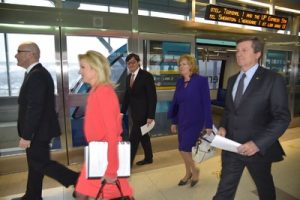
Minister Del Duca and mayors signal support for regional transit centre at Toronto Pearson
By Greater Toronto Airports Authority
Construction Infrastructure airport GTAA Hamilton Toronto Toronto Pearson transit
Minister Del Duca and Mayors signal support for regional transit centre at Toronto Pearson (CNW Group/Greater Toronto Airports Authority)
TORONTO – Today, at an event hosted by the Greater Toronto Airports Authority (GTAA), Transportation Minister Steven Del Duca and local mayors, including Mississauga Mayor Bonnie Crombie, Toronto Mayor John Tory, Brampton Mayor Linda Jeffrey and Kitchener Mayor Berry Vrbanovic, were at Toronto Pearson to learn about the airport’s transit vision. The GTAA shared new research that further supports a proposal for a regional transit centre located at Toronto Pearson, serving as a second major mobility hub for the Greater Toronto Hamilton Area (GTHA).
The research shows a growing demand for transit in the West GTHA, a region currently under-served by transit but experiencing rapid growth. Along with the quantified benefits of reduced congestion and GHG emissions and economic growth, the findings demonstrated strong demand for better transit in the West GTHA:
- The West GTHA generates more than 4.5 million trips per day, representing 35 per cent of the GTHA’s trips. Only seven per cent of these trips are by public transit.
- Nearly twice as many West GTHA commuters travel across the top of the GTA to North Toronto and York Region, the “Northern Arc,” than to downtown Toronto.
- Despite greater demand to the Northern Arc than downtown, greater than 60 per cent of transit trips require at least one connection, with more than 20 per cent requiring two or more. Only 35 per cent of trips downtown require a connection.
- Less than eight per cent of “reverse commuters,” those travelling from Toronto to jobs in West GTHA, commute to work using transit, compared to 42 per cent of West GTHA commuters heading to downtown Toronto.
The Minister and Mayors participated in a briefing on the study, following which they spoke to media about the benefits to the region. The study confirmed that even if the airport did not exist, the area around Toronto Pearson would still be the logical place for a “Union Station West.”
“This opportunity is about more than just getting people to and from the airport; it is about generating a host of benefits for people living and working in the Greater Toronto Hamilton Area. This starts with reduced congestion on the roads around the airport, resulting in more efficient movement of people and goods. The end result would be a more economically competitive region, and one that is better positioned to unlock the significant growth opportunities that the future holds,” said Howard Eng, president and chief executive officer, Greater Toronto Airports Authority.
Last year, the GTAA announced plans to build a regional transit centre on airport property to support both its growth plans and the region’s need for better transit connectivity. The GTAA has indicated it will fund the development and construction of the transit centre at Toronto Pearson. It continues to work with all levels of government to advance plans on priority lines connecting into the regional transit centre.
Located between three municipalities, four major highways and a number of planned and existing transit lines, Toronto Pearson’s location has the unique ability to connect the surrounding region. It’s also situated to effectively serve the transit needs of the West GTHA and those travelling along the ‘Northern Arc,’ while also offering a strategic link to the Toronto-Waterloo Region Corridor, which travels through other important economic areas in the GTHA West, including Brampton and Mississauga. Commuters trying to get around Toronto Pearson, as well as the daily one million trips generated within the Airport Employment Zone, the second largest concentration of jobs in the country, means that a regional transit centre in the area would enable the bundling of trips, increasing the frequency of transit services.
The GTAA will be publishing the full findings in coming months.
SOURCE Greater Toronto Airports Authority 




